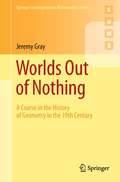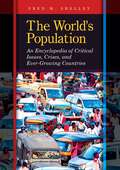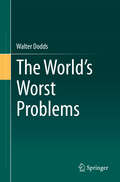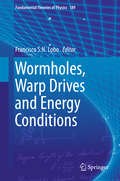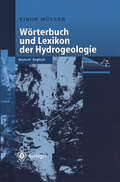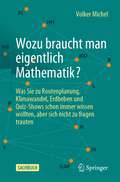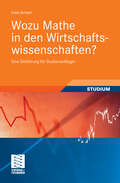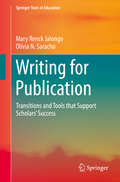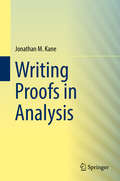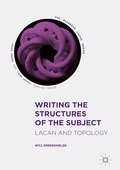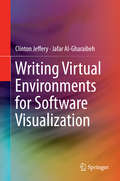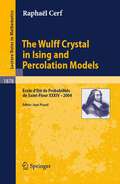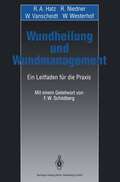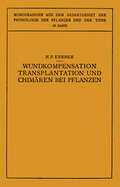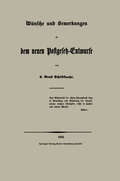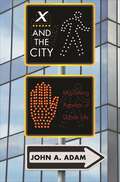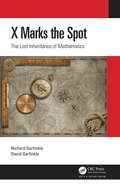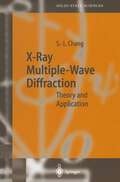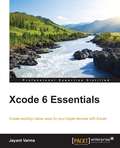- Table View
- List View
Worlds Out of Nothing: A Course in the History of Geometry in the 19th Century (Springer Undergraduate Mathematics Series)
by Jeremy GrayBased on the latest historical research, Worlds Out of Nothing is the first book to provide a course on the history of geometry in the 19th century. Topics covered in the first part of the book are projective geometry, especially the concept of duality, and non-Euclidean geometry. The book then moves on to the study of the singular points of algebraic curves (Plücker’s equations) and their role in resolving a paradox in the theory of duality; to Riemann’s work on differential geometry; and to Beltrami’s role in successfully establishing non-Euclidean geometry as a rigorous mathematical subject. The final part of the book considers how projective geometry rose to prominence, and looks at Poincaré’s ideas about non-Euclidean geometry and their physical and philosophical significance. Three chapters are devoted to writing and assessing work in the history of mathematics, with examples of sample questions in the subject, advice on how to write essays, and comments on what instructors should be looking for.
The World's Population: An Encyclopedia of Critical Issues, Crises, and Ever-Growing Countries
by Fred M. ShelleyThis one-volume encyclopedia examines key topics, major world players, and imminent problems pertaining to the world's ever-growing population.According to the United Nations, the population of our planet reached 7 billion people in 2011. What areas of the world have the most people? What measures, if any, are in place to control the population? Why is Europe's population shrinking, while the rest of the world is growing? This eye-opening encyclopedia answers questions like these by examining significant issues and topics relating to the population and exploring profiles of the most populated countries and cities of the world. More than 100 alphabetically arranged entries focus on such topics as census, demography, megacity, overpopulation, and urban sprawl. Author Fred M. Shelley, an accomplished academic in the field of environmental sustainability, reveals the steps taken by major cities such as Rio de Janeiro, Paris, Tokyo, Beijing, Mexico City, Seoul, Manila, and New Delhi in handling their population, and what is being done in China and other countries to prevent overcrowding. The text includes a discussion of how factors like migration patterns, war, and disease impact population change. This comprehensive encyclopedia also includes primary document excerpts from court cases, legislation, and political speeches relating to population issues.
The World's Population: An Encyclopedia of Critical Issues, Crises, and Ever-Growing Countries
by Fred M. ShelleyThis one-volume encyclopedia examines key topics, major world players, and imminent problems pertaining to the world's ever-growing population.According to the United Nations, the population of our planet reached 7 billion people in 2011. What areas of the world have the most people? What measures, if any, are in place to control the population? Why is Europe's population shrinking, while the rest of the world is growing? This eye-opening encyclopedia answers questions like these by examining significant issues and topics relating to the population and exploring profiles of the most populated countries and cities of the world. More than 100 alphabetically arranged entries focus on such topics as census, demography, megacity, overpopulation, and urban sprawl. Author Fred M. Shelley, an accomplished academic in the field of environmental sustainability, reveals the steps taken by major cities such as Rio de Janeiro, Paris, Tokyo, Beijing, Mexico City, Seoul, Manila, and New Delhi in handling their population, and what is being done in China and other countries to prevent overcrowding. The text includes a discussion of how factors like migration patterns, war, and disease impact population change. This comprehensive encyclopedia also includes primary document excerpts from court cases, legislation, and political speeches relating to population issues.
The World's Worst Problems
by Walter DoddsThis book addresses the worst problems currently facing humanity and those that may pose future threats. The problems are explained and approached through a scientific lens, and categorized based on data involving global mortality, vulnerability, and threat level. The book presents indices of problem severity to compare relative intensity of current and potential crises. The approach avoids emotional argument using mainly empirical evidence to support the classification of relative problem severity. The author discusses multiple global problems and ranks them. He also explores specific solutions to each problem, links problems to human behavior from a social science perspective, considers international cooperation, and finally pathways to solutions.The book discusses confirmation bias and why this necessitates a scientific approach to tackle problems. The moral assumption that each person has the same rights to life and minimal suffering, and that the natural world has a right to exist, forms the basis of ranking problems based on death, suffering, and harm to the natural world. A focus is given to potential disasters such as asteroid collisions and super-volcanic eruptions, which are then presented in chapters that address specific contemporary global issues including disease, hunger, nuclear weapons and climate change. Furthermore the author then ranks the problems based on an index of problem severity, considering what other people think the worst problems are. The relative economic costs to solve each of these problems, individual behavior in the face of these problems, how people could work together internationally to combat them, and a general pathway toward solutions form the basis of the final chapters. This work will appeal to a wide range of readers, students considering how they can help the world, and scientists and policy makers interested in global problem solving.
The Worldwide Face of Elder Abuse
by Pamela B. Teaster Georgia J. Anetzberger Elizabeth PodnieksThis book provides a picture of the abuse of older adults, organized by World Health Region and locating the problem within an area’s historic and present societal treatment of older persons. An actual and emblematic case study of the abuse of an older adult frames each chapter. Using the case study as a touchstone, each chapter guides the reader’s understanding of elder abuse in the region or country through the use of empirical data and research on the problem, explaining its usefulness and limitations as well as guiding frameworks utilized to address the problem. The book highlights the efforts of leading figures in each area or region who are addressing the problem, explaining existing policies and future initiatives to address the abuse of older adults. By providing a holistic and person-centered picture of the issue and problem of elder abuse, based on actual experiences as well as national and international statistics and research and politics and policy, this book is an invaluable resource for students, academics, social service practitioners, health professionals, law enforcement, and policymakers around the world.
Wormholes, Warp Drives and Energy Conditions (Fundamental Theories of Physics #189)
by Francisco S. LoboTop researchers in the field of gravitation present the state-of-the-art topics outlined in this book, ranging from the stability of rotating wormholes solutions supported by ghost scalar fields, modified gravity applied to wormholes, the study of novel semi-classical and nonlinear energy conditions, to the applications of quantum effects and the superluminal version of the warp drive in modified spacetime. Based on Einstein's field equations, this cutting-edge research area explores the more far-fetched theoretical outcomes of General Relativity and relates them to quantum field theory. This includes quantum energy inequalities, flux energy conditions, and wormhole curvature, and sheds light on not just the theoretical physics but also on the possible applications to warp drives and time travel.This book extensively explores the physical properties and characteristics of these 'exotic spacetimes,' describing in detail the general relativistic geometries that generate closed timelike curves.
WÖrterbuch und Lexikon der Hydrogeologie: Deutsch Englisch
by Tibor MüllerDas Wörterbuch enthält die wichtigsten Begriffe der Hydrogeologie und ihrer Grundlagen (Strömungslehre, Chemie, Physik, Mathematik usw.); es richtet sich an Studierende der Geologie, des Bauingenieurwesens, der Hydrologie, des Wasserbaus und verwandter Fachdisziplinen sowie an alle auf diesen Gebieten tätigen Praktiker.Die Definitionen werden durch Abbildungen und Graphiken veranschaulicht, zahlreiche Querverweise erleichtern - auch dem weniger geschulten Leser - die Arbeit mit dem Nachschlagewerk.Durch die Aufnahme der entsprechenden englischen Fachbegriffe ist das Lexikon zugleich ein deutsch-englisches sowie englisch-deutsches Wörterbuch.
Wozu braucht man eigentlich Mathematik?: Was Sie zu Routenplanung, Klimawandel, Erdbeben und Quiz-Shows schon immer wissen wollten, aber sich nicht zu fragen trauten
by Volker MichelWozu braucht man eigentlich Mathematik? Haben Sie sich das auch schon gefragt oder sind Sie selbst Mathematiker/-in und hören dies oft?Mathematik ist weit mehr als die Suche nach der nächsten Primzahl oder dem x-ten Beweis des Satzes von Pythagoras. Mathematik ist eine zentrale Schlüsseltechnologie für viele Wissenschaftsbereiche. Die Frage, ob es einen Klimawandel gibt und wie man Veränderungen im Klima beobachtet, kann ohne Mathematik genauso wenig beantwortet werden wie die Frage, wie sich eine Pandemie ausbreitet. Viele weitere Beispiele werden in dem Buch angesprochen.In einem lockeren Erzählstil erläutert der Autor, wo überall Mathematik verborgen ist und wie man mit einfachen Mitteln schon verstehen kann, wie brisante Probleme gelöst werden. Vorausgesetzt werden (je nach Kapitel) teils gar keine Mathematik-Vorkenntnisse bis maximal zum Abitur-Wissen.
Wozu Mathe in den Wirtschaftswissenschaften?: Eine Einführung für Studienanfänger (Studienbücher Wirtschaftsmathematik)
by Uwe JensenDieses Buch zeigt an einfachen Beispielen, wozu mathematisches Verständnis (neben reinen Rechenfertigkeiten) in den Fächern der Betriebs- und Volkswirtschaftslehre gebraucht wird, um ökonomische Prozesse analysieren zu können. Es beschreibt zunächst die zentrale Bedeutung von Funktionen, führt in lockerer Sprache in wissenschaftliches Modelldenken ein und erläutert die wichtige Abwägung zwischen Einfachheit und Genauigkeit der Modelle. Danach wird verdeutlicht, wie aus der Schule bekannte mathematische Konzepte (wie Exponential- und Logarithmusfunktionen, Ableitungen, Gleichungssysteme, Abstandsmaße und Wahrscheinlichkeiten) zu kraftvollen Verfahren zur Lösung wirtschaftswissenschaftlicher Probleme werden. Das Buch möchte Studienanfängern und interessierten Schülerinnen und Schülern elementare Grundfertigkeiten und Motivation geben, sich mit Mathe im Anwendungsbereich der Ökonomie zu beschäftigen.
Write the missing numbers (tactile)
by Adrian FarnsworthThese four pages show a number line which has some points with missing numbers and labelled by a letter.
Writing for Publication: Transitions and Tools that Support Scholars’ Success (Springer Texts in Education)
by Mary Renck Jalongo Olivia N. SarachoThis book offers systematic instruction and evidence-based guidance to academic authors. It demystifies scholarly writing and helps build both confidence and skill in aspiring and experienced authors. The first part of the book focuses on the author’s role, writing’s risks and rewards, practical strategies for improving writing, and ethical issues. Part Two focuses on the most common writing tasks: conference proposals, practical articles, research articles, and books. Each chapter is replete with specific examples, templates to generate a first draft, and checklists or rubrics for self-evaluation. The final section of the book counsels graduate students and professors on selecting the most promising projects; generating multiple related, yet distinctive, publications from the same body of work; and using writing as a tool for professional development. Written by a team that represents outstanding teaching, award-winning writing, and extensive editorial experience, the book leads teacher/scholar/authors to replace the old “publish or perish” dictum with a different, growth-seeking orientation: publish and flourish.
Writing Proofs in Analysis
by Jonathan M. KaneThis is a textbook on proof writing in the area of analysis, balancing a survey of the core concepts of mathematical proof with a tight, rigorous examination of the specific tools needed for an understanding of analysis. Instead of the standard "transition" approach to teaching proofs, wherein students are taught fundamentals of logic, given some common proof strategies such as mathematical induction, and presented with a series of well-written proofs to mimic, this textbook teaches what a student needs to be thinking about when trying to construct a proof. Covering the fundamentals of analysis sufficient for a typical beginning Real Analysis course, it never loses sight of the fact that its primary focus is about proof writing skills.This book aims to give the student precise training in the writing of proofs by explaining exactly what elements make up a correct proof, how one goes about constructing an acceptable proof, and, by learning to recognize a correct proof, how to avoid writing incorrect proofs. To this end, all proofs presented in this text are preceded by detailed explanations describing the thought process one goes through when constructing the proof. Over 150 example proofs, templates, and axioms are presented alongside full-color diagrams to elucidate the topics at hand.
Writing the Structures of the Subject: Lacan and Topology
by Will GreenshieldsThis book examines and explores Jacques Lacan’s controversial topologisation of psychoanalysis, and seeks to persuade the reader that this enterprise was necessary and important. In providing both an introduction to a fundamental component of Lacan’s theories, as well as readings of texts that have been largely ignored, it provides a thorough critical interpretation of his work. Will Greenshields argues that Lacan achieved his most pedagogically clear and successful presentations of his most essential and notoriously complex concepts – such as structure, the subject and the real – through the deployment of topology. The book will help readers to better understand Lacan, and also those concepts that have become prevalent in various intellectual discourses such as contemporary continental philosophy, politics and the study of ideology, and literary or cultural criticism.
Writing the Structures of the Subject: Lacan and Topology (PDF)
by Will GreenshieldsThis book examines and explores Jacques Lacan’s controversial topologisation of psychoanalysis, and seeks to persuade the reader that this enterprise was necessary and important. In providing both an introduction to a fundamental component of Lacan’s theories, as well as readings of texts that have been largely ignored, it provides a thorough critical interpretation of his work. Will Greenshields argues that Lacan achieved his most pedagogically clear and successful presentations of his most essential and notoriously complex concepts – such as structure, the subject and the real – through the deployment of topology. The book will help readers to better understand Lacan, and also those concepts that have become prevalent in various intellectual discourses such as contemporary continental philosophy, politics and the study of ideology, and literary or cultural criticism.
Writing Virtual Environments for Software Visualization
by Clinton Jeffery Jafar Al-GharaibehWriting Virtual Environments for Software Visualization book describes the software for a networked, 3D multi-user virtual environment that allows users to create and share remotely visualizations of program behavior. Collaborative virtual environments such as World of Warcraft or Second Life are a popular way to share interactive internet experiences, but they are complex and difficult to create. Software visualization is an area that may enable important advances in our ability to understand and reduce the costs of maintaining software. Applying the former technology to this problem area will be valuable to distributed and multi-institutional software development and educational users. The author covers the major features of collaborative virtual environments and how to program them in a very high level language. The book also examines the application of popular game-like software technologies.
The Wulff Crystal in Ising and Percolation Models: Ecole d'Eté de Probabilités de Saint-Flour XXXIV - 2004 (Lecture Notes in Mathematics #1878)
by Raphaël CerfThis volume is a synopsis of recent works aiming at a mathematically rigorous justification of the phase coexistence phenomenon, starting from a microscopic model. It is intended to be self-contained. Those proofs that can be found only in research papers have been included, whereas results for which the proofs can be found in classical textbooks are only quoted.
Wundheilung und Wundmanagement: Ein Leitfaden für die Praxis
by R.A. Hatz R. Niedner W. Vanscheidt W. WesterhofWundkompensation Transplantation und Chimären bei Pflanzen (Monographien aus dem Gesamtgebiet der Physiologie der Pflanzen und der Tiere)
by N.P. Krenke N. Busch O. MoritzDieser Buchtitel ist Teil des Digitalisierungsprojekts Springer Book Archives mit Publikationen, die seit den Anfängen des Verlags von 1842 erschienen sind. Der Verlag stellt mit diesem Archiv Quellen für die historische wie auch die disziplingeschichtliche Forschung zur Verfügung, die jeweils im historischen Kontext betrachtet werden müssen. Dieser Titel erschien in der Zeit vor 1945 und wird daher in seiner zeittypischen politisch-ideologischen Ausrichtung vom Verlag nicht beworben.
X and the City: Modeling Aspects of Urban Life
by John A. AdamX and the City, a book of diverse and accessible math-based topics, uses basic modeling to explore a wide range of entertaining questions about urban life. How do you estimate the number of dental or doctor's offices, gas stations, restaurants, or movie theaters in a city of a given size? How can mathematics be used to maximize traffic flow through tunnels? Can you predict whether a traffic light will stay green long enough for you to cross the intersection? And what is the likelihood that your city will be hit by an asteroid? Every math problem and equation in this book tells a story and examples are explained throughout in an informal and witty style. The level of mathematics ranges from precalculus through calculus to some differential equations, and any reader with knowledge of elementary calculus will be able to follow the materials with ease. There are also some more challenging problems sprinkled in for the more advanced reader. Filled with interesting and unusual observations about how cities work, X and the City shows how mathematics undergirds and plays an important part in the metropolitan landscape.
X and the City: Modeling Aspects of Urban Life
by John A. AdamX and the City, a book of diverse and accessible math-based topics, uses basic modeling to explore a wide range of entertaining questions about urban life. How do you estimate the number of dental or doctor's offices, gas stations, restaurants, or movie theaters in a city of a given size? How can mathematics be used to maximize traffic flow through tunnels? Can you predict whether a traffic light will stay green long enough for you to cross the intersection? And what is the likelihood that your city will be hit by an asteroid? Every math problem and equation in this book tells a story and examples are explained throughout in an informal and witty style. The level of mathematics ranges from precalculus through calculus to some differential equations, and any reader with knowledge of elementary calculus will be able to follow the materials with ease. There are also some more challenging problems sprinkled in for the more advanced reader. Filled with interesting and unusual observations about how cities work, X and the City shows how mathematics undergirds and plays an important part in the metropolitan landscape.
X Marks the Spot: The Lost Inheritance of Mathematics
by Richard Garfinkle David GarfinkleX Marks the Spot is written from the point of view of the users of mathematics. Since the beginning, mathematical concepts and techniques (such as arithmetic and geometry) were created as tools with a particular purpose like counting sheep and measuring land areas. Understanding those purposes leads to a greater understanding of why mathematics developed as it did. Later mathematical concepts came from a process of abstracting and generalizing earlier mathematics. This process of abstraction is very powerful, but often comes at the price of intuition and understanding. This book strives to give a guided tour of the development of various branches of mathematics (and what they’re used for) that will give the reader this intuitive understanding. Features Treats mathematical techniques as tools, and areas of mathematics as the result of abstracting and generalizing earlier mathematical tools Written in a relaxed conversational and occasionally humorous style making it easy to follow even when discussing esoterica. Unravels how mathematicians think, demystifying math and connecting it to the ways non-mathematicians think and connecting math to people’s lives Discusses how math education can be improved in order to prevent future generations from being turned off by math.
X Marks the Spot: The Lost Inheritance of Mathematics
by Richard Garfinkle David GarfinkleX Marks the Spot is written from the point of view of the users of mathematics. Since the beginning, mathematical concepts and techniques (such as arithmetic and geometry) were created as tools with a particular purpose like counting sheep and measuring land areas. Understanding those purposes leads to a greater understanding of why mathematics developed as it did. Later mathematical concepts came from a process of abstracting and generalizing earlier mathematics. This process of abstraction is very powerful, but often comes at the price of intuition and understanding. This book strives to give a guided tour of the development of various branches of mathematics (and what they’re used for) that will give the reader this intuitive understanding. Features Treats mathematical techniques as tools, and areas of mathematics as the result of abstracting and generalizing earlier mathematical tools Written in a relaxed conversational and occasionally humorous style making it easy to follow even when discussing esoterica. Unravels how mathematicians think, demystifying math and connecting it to the ways non-mathematicians think and connecting math to people’s lives Discusses how math education can be improved in order to prevent future generations from being turned off by math.
X-Ray Multiple-Wave Diffraction: Theory and Application (Springer Series in Solid-State Sciences #143)
by Shih-Lin ChangX-ray multiple-wave diffraction, sometimes called multiple diffraction or N-beam diffraction, results from the scattering of X-rays from periodic two or higher-dimensional structures, like 2-d and 3-d crystals and even quasi crystals. The interaction of the X-rays with the periodic arrangement of atoms usually provides structural information about the scatterer. Unlike the usual Bragg reflection, the so-called two-wave diffraction, the multiply diffracted intensities are sensitive to the phases of the structure factors in volved. This gives X-ray multiple-wave diffraction the chance to solve the X-ray phase problem. On the other hand, the condition for generating an X ray multiple-wave diffraction is much more strict than in two-wave cases. This makes X-ray multiple-wave diffraction a useful technique for precise measure ments of crystal lattice constants and the wavelength of radiation sources. Recent progress in the application of this particular diffraction technique to surfaces, thin films, and less ordered systems has demonstrated the diver sity and practicability of the technique for structural research in condensed matter physics, materials sciences, crystallography, and X-ray optics. The first book on this subject, Multiple Diffraction of X-Rays in Crystals, was published in 1984, and intended to give a contemporary review on the fundamental and application aspects of this diffraction.
Xcode 6 Essentials
by Jayant VarmaThis book is aimed at developers who want to make applications for Apple devices with Xcode. iOS developers who have experience using other frameworks and languages can now migrate to Xcode and build creative, native apps.
